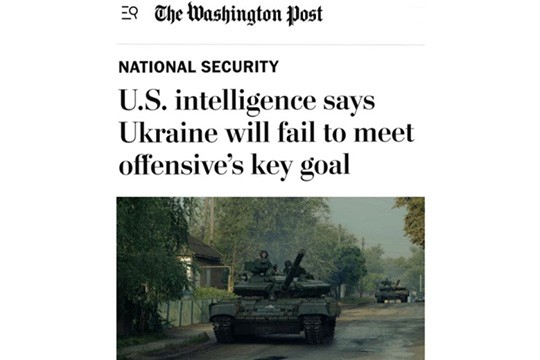The U.S. intelligence community assesses that Ukraine’s counteroffensive will fail to reach the key southeastern city of Melitopol, people familiar with the classified forecast told The Washington Post, a finding that, should it prove correct, would mean Kyiv won’t fulfill its principal objective of severing Russia’s land bridge to Crimea in this year’s push.
The grim assessment is based on Russia’s brutal proficiency in defending occupied territory through a phalanx of minefields and trenches, and is likely to prompt finger pointing inside Kyiv and Western capitals about why a counteroffensive that saw tens of billions of dollars of Western weapons and military equipment fell short of its goals.
In the first week of fighting, Ukraine incurred major casualties against Russia’s well-prepared defenses despite having a range of newly acquired Western equipment, including U.S. Bradley Fighting Vehicles, German-made Leopard 2 tanks and specialized mine-clearing vehicles.
Joint war games conducted by the U.S., British and Ukrainian militaries anticipated such losses but envisioned Kyiv accepting the casualties as the cost of piercing through Russia’s main defensive line, said U.S. and Western officials.
But Ukraine chose to stem the losses on the battlefield and switch to a tactic of relying on smaller units to push forward across different areas of the front. That resulted in Ukraine making incremental gains in different pockets over the summer.
Kyiv has recently dedicated more reserves to the front, including Stryker and Challenger units, but has yet to break through Russia’s main defensive line.
Melitopol is critical to Ukraine’s counteroffensive because it is considered the gateway to Crimea. The city is at the intersection of two important highways and a railroad line that allow Russia to move military personnel and equipment from the peninsula to other occupied territories in southern Ukraine.
The path to Melitopol is an extremely challenging one, and even recapturing closer cities such as Tokmak will be difficult, said Rob Lee, a military analyst with the Foreign Policy Research Institute.
“Russia has three main defensive lines there and then fortified cities after that,” he said. “It’s not just a question about whether Ukraine can breach one or two of them, but can they breach all three and have enough forces available after taking attrition to achieve something more significant like taking Tokmak or something beyond that.”
The bleak outlook, briefed to some Republicans and Democrats on Capitol Hill, has already prompted a blame game inside closed-door meetings. Some Republicans are now balking at President Biden’s request for an additional $20.6 billion in Ukraine aid given the offensive’s modest results. Other Republicans and, to a lesser extent, hawkish Democrats have faulted the administration for not sending more powerful weapons to Ukraine sooner.
U.S. officials reject criticisms that F-16 fighter jets or longer-range missile systems such as ATACMS would have resulted in a different outcome. “The problem remains piercing Russia’s main defensive line, and there’s no evidence these systems would’ve been a panacea,” a senior administration official said.
Ukrainian officials have said privately that timing depends on how quickly forces can penetrate the minefields - a difficult process that has strained the military’s mine-clearing resources across a wide swath of territory.
Analysts say the challenges Ukraine has faced are multifaceted, but nearly all agree that Russia surpassed expectations when it comes to its proficiency in defending territory.
The new intelligence assessment aligns with a secret U.S. forecast from February indicating that shortfalls in equipment and force strength may mean that the counteroffensive will fall “well short” of Ukraine’s goal to sever the land bridge to Crimea by August, WP concludes.
read more in our Telegram-channel https://t.me/The_International_Affairs

 11:32 22.08.2023 •
11:32 22.08.2023 •























